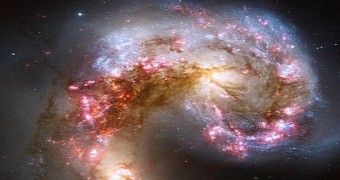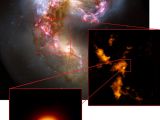With the help of the Atacama Large Millimeter/submillimeter Array, an astronomical interferometer of radio telescopes in the Atacama desert in northern Chile, scientists zoomed in on a previously undocumented cosmic cloud of molecular gas.
The cloud sits some 50 million light-years away from our planet, nestled in the midsts of a pair of merging galaxies dubbed NGC 4038 and NGC 4039, i.e. the Antennae galaxies.
Unlike other cosmic clouds astronomers have until now had the chance to study, this one is not only freakishly big but also insanely dense. Thus, the newly discovered cloud is said to hold the mass equivalent of 50 million stars like our Sun.
The cloud is kind of, sort of like a dinosaur egg about to hatch
This cosmic cloud of molecular gas revealed by the Atacama Large Millimeter/submillimeter Array does not appear to hide any newly formed stars deep inside its entrails.
Still, researchers with the National Radio Astronomy Observatory say that, given its size and density, there is little doubt that it will very soon birth an army's worth of fiery celestial bodies.
Specifically, the scientists argue that the cloud, nicknamed the Firecracker, is on the verge of coughing out a globular cluster, which they describe as a collection of up to a million stars.
Admittedly, plenty of globular clusters have been spotted over the years in galaxies scattered all across the cosmos. Still, the birth of such agglomerations of stars has never before been witnessed.
“To discover something that has all the characteristics of a globular cluster, yet has not begun making stars, is like finding a dinosaur egg that’s about to hatch,” says astronomer Kelsey Johnson.
“Until now, clouds with this potential have only been seen as teenagers, after star formation had begun. That meant that the nursery had already been disturbed,” he adds.
In the series of images provided by the National Radio Astronomy Observatory team and available below, merging galaxies NGC 4038 and NGC 4039 are shown in the upper view.
The center right image shows a collection of gas clouds inside this mingling pair of galaxies, and the bottom view shows the now star-free cloud that astronomers believe will soon form a globular cluster.
Globular clusters are present by the dozens in our home galaxy
Evidence indicates that most of the globular clusters that populate the cosmos formed around 12 billion years ago, when the universe was still young. Since heavy metals weren't easy to come by in those days, the stars that comprise them are rather low on these ingredients.
Interestingly, it looks like our home galaxy, the Milky Way, also holds a few dozen globular clusters. Researchers have so far counted about 150, but many others could be waiting to be discovered.

 14 DAY TRIAL //
14 DAY TRIAL // 

